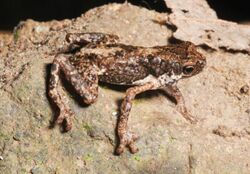Biology:Pelophryne brevipes
| Pelophryne brevipes | |
|---|---|

| |
| Male Pelophryne brevipes from Mount Lumot | |
| Scientific classification | |
| Domain: | Eukaryota |
| Kingdom: | Animalia |
| Phylum: | Chordata |
| Class: | Amphibia |
| Order: | Anura |
| Family: | Bufonidae |
| Genus: | Pelophryne |
| Species: | P. brevipes
|
| Binomial name | |
| Pelophryne brevipes (Peters, 1867)
| |
| Synonyms[2] | |
| |
Pelophryne brevipes is a species of toad in the family Bufonidae. It is endemic to the Philippines and found on the islands of Mindanao and Basilan.[2] Records from elsewhere in Southeast Asia (as in IUCN (2004)[1]) refer to Pelophryne signata or possibly other species.[3][4] Common names Southeast Asian toadlet[5] and Zamboanga flathead toad have been coined for it.[2]
Description
Adult males measure about 16–18 mm (0.6–0.7 in) and adult females about 17 mm (0.7 in) in snout–vent length. The finger discs are expanded but truncate. Males have mandibular spines.[4] The male advertisement call is a soft "beep".[6]
Habitat and conservation
Pelophryne brevipes occurs on the surfaces of shrubs and understory trees near running water. It appears to tolerate some degree of forest disturbance and has been found on ornamental plants around buildings on forest edges.[6] Pelophryne brevipes has been assessed as of "least concern" by the International Union for Conservation of Nature (IUCN), but this assessment assumes that the species has a broad range in Southeast Asia[1] and needs updating.[6]
References
- ↑ 1.0 1.1 1.2 IUCN SSC Amphibian Specialist Group (2020). "Pelophryne brevipes". IUCN Red List of Threatened Species 2020: e.T134122323A176850693. doi:10.2305/IUCN.UK.2020-3.RLTS.T134122323A176850693.en. https://www.iucnredlist.org/species/134122323/176850693. Retrieved 17 November 2021.
- ↑ 2.0 2.1 2.2 Frost, Darrel R. (2019). "Pelophryne brevipes (Peters, 1867)". Amphibian Species of the World: an Online Reference. Version 6.0. American Museum of Natural History. http://research.amnh.org/vz/herpetology/amphibia/Amphibia/Anura/Bufonidae/Pelophryne/Pelophryne-brevipes. Retrieved 22 March 2019.
- ↑ Frost, Darrel R. (2019). "Pelophryne signata (Boulenger, 1895)". Amphibian Species of the World: an Online Reference. Version 6.0. American Museum of Natural History. http://research.amnh.org/vz/herpetology/amphibia/Amphibia/Anura/Bufonidae/Pelophryne/Pelophryne-signata. Retrieved 22 March 2019.
- ↑ 4.0 4.1 Inger, Robert F.; Stuebing, Robert B. (2009). "New species and new records of Bornean frogs (Amphibia: Anura)". Raffles Bulletin of Zoology 57: 527–535. http://lkcnhm.nus.edu.sg/nus/pdf/PUBLICATION/Raffles%20Bulletin%20of%20Zoology/Past%20Volumes/RBZ%2057(2)/57rbz527-535.pdf. Retrieved 2019-03-22.
- ↑ "Pelophryne brevipes". AmphibiaWeb. University of California, Berkeley. 2019. https://amphibiaweb.org/species/392. Retrieved 23 March 2019.
- ↑ 6.0 6.1 6.2 Sanguila, Marites B.; Cobb, Kerry A.; Siler, Cameron D.; Diesmos, Arvin C.; Alcala, Angel C.; Brown, Rafe M. (2016). "The amphibians and reptiles of Mindanao Island, southern Philippines, II: the herpetofauna of northeast Mindanao and adjacent islands". ZooKeys (624): 1–132. doi:10.3897/zookeys.624.9814. PMID 27833422.
Wikidata ☰ Q2236027 entry
 |


